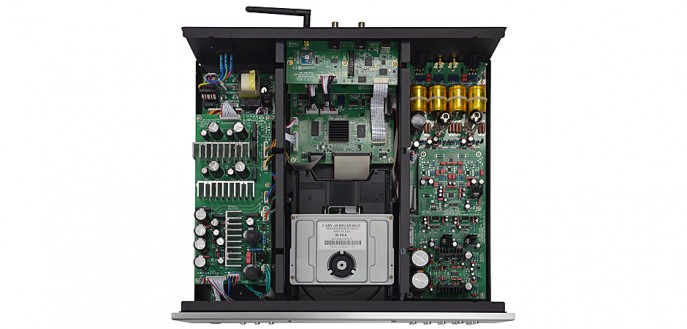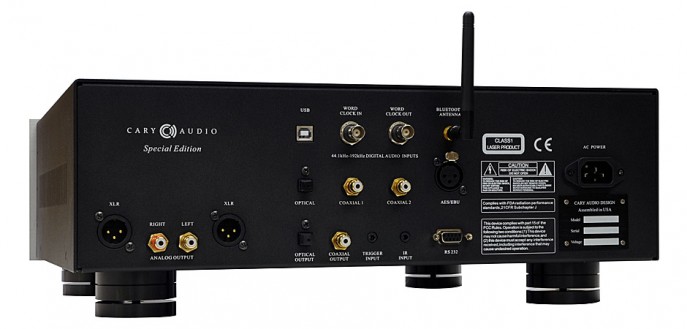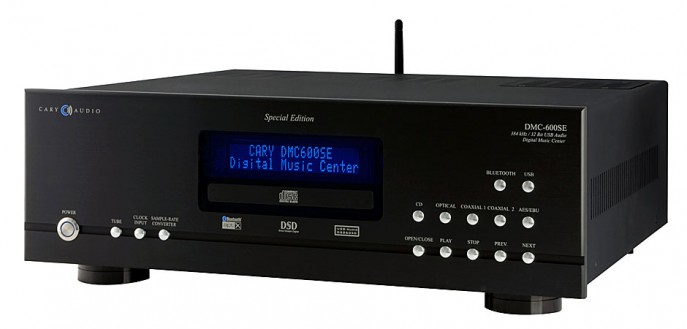When trying to make a delicious tasting chicken soup, like the kind grandma used to serve up to the family, you must first make sure that you have all of the expertise and patience that it takes to be a successful soup chef. You must be willing to fail multiple times, experimenting and tweaking your flavorings and amounts, and until you finally get all of the proper ingredients to happily co-exist in one synergistic pot, creating one total taste sensation that brings a smile to anyone’s face who takes a sip. It has to look right, smell right, and taste right. It must be able pass grandma’s scrutiny under years of know-how, that she herself spent years shaping and perfecting under her own mentor’s watchful eyes. It also has to somehow contain the magic ingredients that will cure the common cold, and make your world a more enjoyable place to live in.

History of Cary Audio:
Cary Audio has been proudly making high quality vacuum tube equipment since 1989. Denis Had, founder of Cary, starting building his first projects on his living room table. That eventually blossomed into the company that we know it as today. A little over 10 years ago, Cary Audio started a product line for home theater and associated digital components. Billy Wright, the President of Cary, speaks very highly about his talented in-house resources, that have developed a multitude of their remarkable modern-day solid-state offerings. I myself currently own and enjoy a Cary Cinema 5 350 watt/channel times 5, home theater amp that powers my Vienna Acoustic mains, center and surrounds, since it came to market. I have also previously owned their world renowned 303/300 CD player in my ever-changing living room setup, and their Cary Xciter DAC that I had won at a Head-Fi National Meet raffle on the West Coast in the late 2000’s. So, you can safely say that I have had a wee bit of experience with Cary Audio and their products for over a decade.
At that time, the brains behind the innovations was Dennis Had, who has since retired, but still tinkers around, building products that bear his name. A top-tier audio manufacturer like Cary, knows through years of trials, tribulations, and experimentation, that it takes dedication to manufacturing high quality audio components good enough to showcase it’s name. Making fantastic 2-channel tube amps to power speakers and headphones like the Cary 300SEI, is one thing, but when the world turned it’s direction to digital, and up and down waveforms transition to straighter ones and zeros, a savvy company will know how to stay true to their legacy products, but also to move forward and stay on top of whatever leading edge technology is just around the corner. This is what the Cary Audio DMC-600SE Digital Music Center is all about!
Throughout my career in audio as a hobbyist and a salesman, I’ve seen a multitude of different ideas tried in an effort to combine different aspects of the audio chain, into different black boxes. It is safe to say, that one of the best ways to achieve a superior audio chain that creates beautiful sounds with the least amount of electrical interference as possible, is to isolate the components, so they can be left alone to do their assigned job properly and efficiently. In this day of belt-tightening corporate America, it’s employees are assigned many hats for less salary, only to find that when people have to perform multiple job descriptions, we become jacks of all trades, and masters of none”. We have lost some of our expertise, and as customers, we have become far to familiar and have fallen complacent, knowing that we have to settle for a lesser degree of service than what we were used to.
Gone are the days of specialists who do only one thing really well. It is cost prohibitive to run a company like that. Similarly, audio components are the same way. When you buy a $400 brick and mortar brand home theater receiver, it usually houses the amp, pre-amp, power supply, tuner, phonostage, digital inputs, analog outputs and codec software, all in one big shiny box. Everything is sharing the same internal power supply, and just like riding the subway in the winter, when one person sneezes, everyone on that train is going to catch the yucky stuff that is bouncing around inside it’s walls. Well, the same holds true for integrated components. The power supply is the person who sneezes, and RFI and EMI is the yucky stuff that causes everyone else the inevitable harm.
By separating components into their own unique worlds, it allows each component to excel at what they do best, with less hurdles to jump over to achieve it’s final output. Of course this is a more expensive approach, but I am hoping that if you are reading a review on an $8,000 Music Center, then you understand the theory, and try to spend your money on the best possible audio components that your budget will accommodate. Hopefully, that includes you being able to split up some the black boxes you will purchase. Whether it’s having a 2-box headphone amplifier with an external power supply, or just separating it down to a source feeding a pre-amp, which then in-turn feeds an amp, it’s most likely going to sound better than an all-in-one solution.
In the early 2000’s, Adcom made a valiant effort, designing a 2-box approach, by placing the tuner in with the pre-amp. Tuners and pre-amps don’t have too much of a bad effect on each other. Adcom kept the amplifier separate, since the amp is the biggest offender of producing electrical noise. This also allowed users with a case of upgrade-it is”, to be able to purchase a better or higher powered amp down the line, without incurring the cost of changing out their pre-amp or radio tuner. If you are wondering what a radio tuner is…yes, it is kind of like satellite radio…now go away, you’re way too young and I’m way too old! Other companies also did various things to make components sound better by utilizing different components in their chain.
What Cary has done here, in keeping up with the times, is to offer a different solution that makes tremendous sense, since a good portion of high resolution music is now digital. Even though physical media is still being used, it’s falling by the wayside as memory becomes cheaper, disc drives are becoming more scarce, and bit rates and frequencies are improving how we hear our adored music of yesteryear, and currently recorded masterpieces destined to be future oldies but goodies.
The wonderful crew over at Moon Audio, in conjunction with Cary Audio, afforded me the privilege of being permitted to review this little piece of audio heaven.
The Moon Audio Story (everything you wanted to know, but were afraid to ask):
I’ve known Drew Baird of Moon Audio for approximately 13 years. We’ve acknowledged each other in audio meets and shows all across the country. From 2004 – 2010, I ran or helped run personal audio Head-Fi NYC regional and national meets and get-togethers in the fall or spring somewhere in the Long Island vicinity. I was fortunate enough to also be in attendance at other local meets in different parts of the country, and I can honestly say that I don’t remember a time that Drew wasn’t at one of them, gently smiling from behind his vendor table, proudly displaying his wares. Drew studied both Acoustical and later, Structural Engineering from 1987 to 1992. His original dream was to create and sell speakers, but it was a difficult industry to turn a profit in, unless you bought parts and components in bulk and sold a lot of units. So he turned to only building speakers for himself.
To fund his own audio obsession, he bought longer runs of the cables that he needed for his own home system, cut them into smaller pieces, experimented with modifications, and in 2000, started selling Interconnects and Speaker cables on Ebay and Audiogon. He was fortunate in his sales, and in 2001, Drew launched his first basic website, where he promoted cable repair, which in turn, afforded him the luxury to experiment with cabling at the expense of the leftovers from the requests and investments of others, who paid him for special projects, in which he exceled in.
Drew Baird named his company Moon Audio”, not because of his fascination with Astronomy, but because it was an easy name to remember. And he was right. Moon Audio is known, and has sales all around the world. I asked him where his Dragon Series of cables came from, and he explained that it came from the fact that Dragons were so popular in Asia, which were a large percentage of his sales at that time, and in Mythology, which he is fond of, and since they were known in all different colors, such as Black, Blue, Silver, etc. it would be apropos to create a whole line of special cables with each color. He started with the Silver Dragon, and to this day, it is still his best selling line. In 2002, Nicole and Drew Baird upgraded their website to look more professional.
Then in 2002, due slightly in part to his success on Audiogon, he received a call from Jude Mansilla of Head-Fi.org. Jude was building a small empire of his own and tasked Drew to create an improved and better sounding cable for his Sennheiser HD600’s, which was one of the best headphones currently available at that time. Little did Drew know, that this chance introduction to Jude was the beginning of very good things to come for this over-achieving, cable designing entrepreneur!
His original wire configuration started out as 4 conductor solid copper core, which Drew changed to 8 conductor stranded silver cable, because the solid copper core was exceedingly demanding to work with, while endeavoring to terminate the wire for Sennheiser’s specific 2-pin configuration.
Meanwhile back at the speaker farm, Drew was having an arduous time trying to voice the sound of his his personally build speakers. He confesses that the most difficult task, of picking the proper crossovers, was an expensive and time-consuming journey. He then turned to the help of a DEQX processor, which afforded him the capability to change his desired crossover points and active equalization on the fly, by simply utilizing the DEQX’s software rather than swapping in and out passive crossover hardware. The DEQX became the first product that Drew sold on his website that wasn’t something built by him and it is still sold on his website today. 2003 marked the beginning of Moon Audio’s venture into becoming a distributor, as well as a manufacturer.
Being located in Cary, North Carolina, was a convenience that afforded Moon Audio the ability to start selling Cary Audio products, and thus forged the business relationship between Moon and Denis Had, founder of Cary Audio. Cary products and components were a welcome addition to Moon Audio’s product lineup. A beautiful collaboration was formed, and spawning out of Denis Had’s retirement, came a product first, between the two great minds. Their product is the Dragon Inspire IHA-1 tubed headphone amp. The Dragon Inspire is a transformer-coupled design, with a clean and straightforward signal path throughout.
Drew Baird was ready in the fall of 2008 to inform his weekly daytime engineering job that he was giving his notice and going out fully on his own. He planned on starting 2009 as a self employed, self-sufficient businessman. But in October of 2008, in the middle of the Rocky Mountain Audio Festival in Denver, Colorado, cell phones starting ringing in unison like something straight out of a Stephen King thriller. Some of the manufacturer’s financial advisors were calling to tell them that the stock market had fully collapsed, the bubble had burst, and to hold onto their money. They were being advised to only make frugal business decisions, because the road ahead was going to be rough. Drew once again, found his timing to be fortunate, and he held onto his day job”, as we say.
Instead of being thin times for Moon Audio, it turned out to be just the opposite. People were moving away from the larger purchases, holding onto their finances, and the portable market became a profitable one. One that Drew was right on the precipice of. After the market started to pick up and people were buying better audio again, he left his 9-5 job and moved full time into making Moon Audio what it is today. Right now they employ 5 people and they hope to add 2 more this year. Moon has been working with Apple, getting certified to make lightning cable products, eventually transitioning into USB-C products.

The Cary DMC 600SE Music Center (A complicated name for a complicated machine!):
Upon receiving this substantially potent, black box of engineering marvel, the first thing that I noticed was how truly hefty this unit is! Built using specs as what I would delicately define as somewhere between an Abrams tank and Fort Knox”! Housed inside this tasty morsel is a sturdily built CD transport, multiple parallel DAC topology (with 3 DACS consisting of 6 channels, 3 channels per side), a fully integrated (or fi”, as Cary terms it) Bluetooth implementation boasting a CSR aptX® lossless Bluetooth receiver. Moving on, there is a dedicated 128-bit DSP engine (which works in tandem with Cary’s OSO™ Reclocking feature), an XMOS xCore USB Asynchronous engine (for accepting Hi-Res digital computer files), and their DiO™ (Dual Independent Output”) solid state and tubed output stages.

One advantageous luxury of their DiO™ component strategy is that you get to choose between a solid state, and a tubed output stage on the fly! All you hear is a one second pause when you press the T” button, either on the face of the unit, or on the remote, and voilà – instantaneous alternate parallel universe! On average, I enjoyed the solid-state stage more for hard-driving rock, modern jazz, reggae, and electronica. The tubed output option tickled my fancy more for enjoying delectable old-school Jazz trios, quartets, quintets, and delicately complicated, classy Jazz vocals.
My review unit is the better equipped of the 2 offerings in this line. The DMC-600SE, like the non-SE model, delivers bit-perfect PCM audio to the party, at up to 32-bit/384kHz in native audio. If you have DSD computer files and a software player like Audirvana, you can input DSD files from USB-A on your computer or laptop, into USB-B in the back of the Cary. The USB files get translated via an XMOS xCore USB Asynchronous engine. You simply need to direct the sound properties of your computer to pick the xCore output option that conveniently appears through simple plug and play. This is the way it works on my Mac-tops”, but for a PC, you can easily download the drivers on Cary’s website. The SE version ups the ante by including the ability to utilize external master clocks, but Cary boasts that their homegrown internal clock is something to be taken seriously.
There are connections on the back panel for World Clock input for external clocks, and output connections to connect to an external source. Also included on the back panel, are a menagerie of connections needed to accomplish the input of digital signals using USB, optical, 2 coaxials, AES/EBU, and RS-232. There are both coaxial and optical-out ports, for sending the digital 0’s and 1’s from the Cary CD transport to an alternate external DAC. I used this option to compare the internal DAC’s in the Cary to superior and inferior DACs in my possession, such as the higher priced dedicated Lampizat0r Big 7 and Emm Labs Dac 6e DACs, and the lesser-priced Emotiva DC-1 Dac/Amp combo. There is also a trigger input, IR input and in the output section of the back panel real estate, both balanced XLR and single-ended RCA options are also waiting to play. Last, but not least, offering yet another way to transmit digital signals into this big, black box, which would probably bleed big, black blood, is a Bluetooth input antenna peeking it’s head up on a rotating connector.

The last feature I want to describe is Cary Audio’s TruBit™ Upsampling process. There is an internal dedicated 128 bit DSP engine which provides (through a user-selectable button on the face and on the remote), the listener a choice of up to 7 different sample rates, that when utilized, increases the bit depth to 32 bits to maximize the sound quality. On the front display, you can see what is operating at the time, whether it is one of the various digital inputs, or the internal CD transport. When you choose the upsampling option, on the left side it shows you the frequency coming in, and on the right it shows the upsampled frequency going out. This is both an appropriate and suitable amenity. I personally found that certain recordings benefit from upsampling, and others don’t. Not every recording is destined for greatness, but the well made ones will. Cary prides themselves of their technology, because it is also used in tandem with their OSO™ Reclocking feature, which crosschecks the upsampled signal, six ways from Sunday, to ensure the signal is as close as the original native signal. Cary claims that the signal should be free from any digital artifacts. What does this mean in layman’s terms? Hopefully, the DMC-600 offers up the best sound that can be achieved from your digital music. I know, I know. I just should have said that in the first place (:->).
Now we can see why this component is called a Digital Music Center”! It is the Grand Central Station of modern-day digital travel.

The good stuff that it does:
So, lets see if I can answer the mystical question, Does the Cary Music Center and the other pretty black boxes make beautiful music together? Let’s dance…
There are so many ways to have good, clean fun with this box. Initially I brought my best headphones out to play. I utilized my Sennheiser HD800’s and my HiFiMAN HE1000’s running into my magnificent Well’s Audio Enigma headphone amp, and then later transitioned to my speaker setup (Cary>McIntosh pre>Cary Cinema 5>Vienna Acoustic Strauss mains). I started out with the most basic function that we all have used since 1984. The first physical media CD that I placed in the tray is from one of my all-time favorite reference recordings from Freddie Hubbard, entitled Red Clay”. It is a stellar recording, engineered by Rudy Van Gelder from back in 1970. I have the 24-bit Japanese re-mastered version from 2000. It showcases Joe Henderson, Herbie Hancock, Ron Carter, and Lenny White. It doesn’t get much better than this, and when you factor in a top-notch recording, it is perfect album to use for comparison.
First I tried the internal CD/DAC option, choosing the second song Delphia” as is, with no upsampling. I experimented with both the solid state and tube outputs on the Cary. I had stated previously that I enjoyed the tube output better with most of the older jazz recordings, but in this case, being a modern jazz/reggae compilation, the soundstage collapsed a bit and the presentation sounded slightly muffled. So I turned to the solid-state stage option. The song carried on in all of it’s infinite glory, and as it approaches the 1:00 minute mark, it gets pianissimo, with just the diminished sounds of the Hammond B-3 organ and soft, deliberate taps of the hi-hat cymbal playing in the upper right hand corner. It sounded truly engaging. I started to sample the same section as I increased the upsampling, first 48, then 88.2>96>176.4>192, to eventually 352.8 and 768. This upsampling benefit seemed to terminate around 192. After that, the recording starting getting smeared and confused.
I then auditioned the Cary internal CD tray as a transport, and outputted the digital signals via coaxial into my Lampizat0r Big 7. The difference was not subtle at all. In fact, it was angels harkening” better. In all fairness, the Lampizat0r is $10,500 by itself, but I needed to see if the Cary could hold it’s own against it. Please don’t misunderstand me. The Dacs in the Cary are no slouches, and I would quantify the difference as being an approximate 20% step down. On the other side of the coin, comparing the Cary Dacs against the Emotiva, it made me think that Emotiva forgot to include a Dac in their Dac. It was seriously better. This goes back to allowing each separate box component to be a Master of its trade, and not a Jack of all”. For what the Cary offers, in it’s price range, is astounding. But there’s always the possibility of something better as we rise up the money tree. I wanted to compare to something in the middle, like my Emm Labs Dac 6e, but the only sound I could get out of the Meitner Dac was a horrifying squeal.
Using my new Macbook 12” with Audirvana, digitally through the 600SE’s USB input, afforded me to play the best and finest music files available to mankind. I demo’d files of all shapes, sizes, and qualities, but the one that really rocked my boat on the Cary, was a good ‘ole 16/44 rip of a little known, but tremendously well-recorded album by Ernest Ranglin named, Modern Answers to Old Problems”. Very appropriate title for this review, no? It contains a masterful use of Ranglin’s Afro-Jamaican guitar jams, with a dose of jazz and reggae sprinkled throughout, and breathtakingly beautiful female vocals to intensify the flavorings. Just like Grandma’s chicken soup…mighty tasty. Ernest is a tenured soul who plays on dozens of albums. This album really allowed me to get a good sense of the soundstage, air and instrument placement. I’ve listened to this album for a long time, and the Cary 600 does it accurately. The tonal balance is precisely where I would expect a recording of this magnitude to be. With regards to macrodynamics, the African drums and percussion held their own, and never fell short when blending with the guitar, keyboards and vocals. Instrument detail was never overshadowed by this massive blend of happy instrumentals. A difficult task to accomplish, and the Digital Music Center took on the challenge gracefully and commendably.
Summing up:
The Cary DMC-600SE is magnificent piece of equipment that performs many functions, and implements them admirably. If you factor in the price of a quality stand-alone transport, a competitive higher-end, home grown dac compliment, along with two completely independent output stages, and multiple digital input options, then the price is right in line with most other equally equipped competitive, multi-box offerings. Couple that with Cary’s own upsampling processes, and crosschecking software which accomplishes bit-perfect output, and anyone who is an owner of this unit, stands to be a proud owner. It is a well thought-out device that suits many needs in the task of taking 0’s and 1’s, and turning them into sweet sounding music in your home. And after all, isn’t that what it’s all about?
Associated Components:
Amplification
Headphone:
Wells Audio Enigma
Krell KSA-5 w/ full Blackgate Cap upgrade
Speaker:
Cary Cinema 5
External Dacs
Lampizat0r Big 7
Emotiva DC-1
Emm Labs Dac 6e
External Sources
Theta Data CD Transport
Macbook 12″ w/ Audirvana
Cabling WyWires exclusively used throughout
Headphones
HiFiMan HE1000
HiFiMan HE-6
Sennheiser HD800
Bowers and Wilkins P7
Noble K10 Custom
Manufacturer’s links:
Available at Moon Audio
http://www.moon-audio.com/cary-audio-dmc-600se-digital-music-center.html
- 106 Brady Ct.
- Cary, NC, 27511
- Private appointments only.
- Please call 919.649.5018 to schedule.















Want to join discussion?
Feel free to contribute!